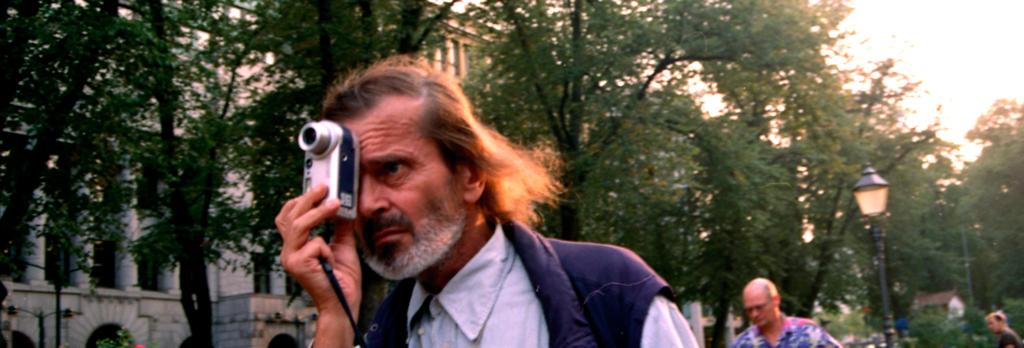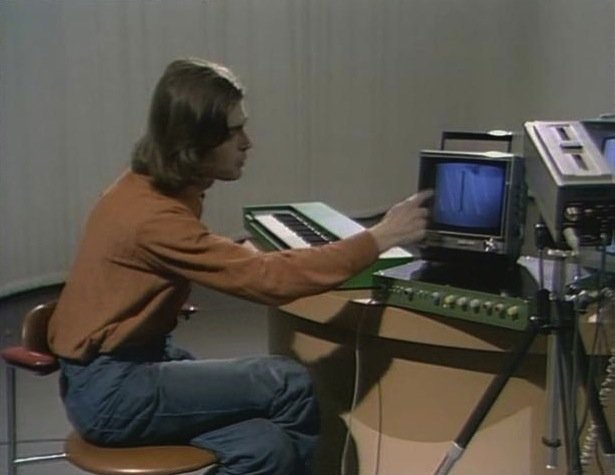



Featured image: MIKA TAANILA – Erkki Kurenniemi : The Dawn of Dimi
Press Release for print (pdf 650k)
HTTP’s debut exhibition brings you work by two extraordinary Finnish artists. This show offers London an exhilarating introduction to the intriguing and dynamic world of technological art practice. The first of a series of exhibitions and events showing mixes of screen-based and physical artworks. Mika Taanila’s documentary film ‘The Future Is Not What It Used To Be’ entwines the past with the present.
In this exhibition, his representation of Erkki Kurenniemi’s philosophical journey through digital possibility is juxtaposed, projected in the same space with a physical artwork from that same history, in the form of DIMI-A machine (Digital Music Instrument, Associative Memory).
We invite you to come to the opening of the exhibition and the gallery to view the work and to meet the artists in person.
Mika Taanila
Born 1965 in Helsinki where he lives and works. Mika Taanila is an artist working fluently in the fields of documentary filmmaking and visual arts. His films deal with the the significant and alarming issues of human engineering and urban artificial surroundings. Taanila specializes in the futuristic ideas and utopias of contemporary science.
The Future Is Not What It Used To Be (Finland 2002)
The Future is Not What It Used To Be is a documentary by Mika Taanila, the director of Futuro – A New Stance for Tomorrow (1998). It features never-before-seen archival material from the early years of electronic art, including excerpts from Kurenniemi’s unfinished experimental short films. The documentary entwines the past with the present, i.e. with the protagonist’s manic archival project, in which Kurenniemi records his thoughts, everyday observations, images and objects, constantly and obsessively. All this in an effort to combine man and machine – to reconstruct the soul of man. (avanto festival, 2002)
Erkki Kurenniemi
Born 1941 in Hämeenlinna, Finland. A pioneer of electronic art in Finland, Erkki Kurenniemi, composed computer-based music and designed his own instruments as early as the 1960’s. His career embraces music, film, computers, robotics – in other words, both art and science – with natural ease. He is a nuclear scientist/inventor/artist, whose projects and ideas have been surprisingly ahead of their times.

He is best known as a designer of unique electronic instruments at Helsinki University’s Department of Music during the 1960s. He subsequently had an impressive career as a pioneer of industrial automation at Rosenlew in the 70s, an automation designer in Nokia’s cable division in the early 80s, and as head of exhibition planning at the Heureka Science Centre in 1987-1999.
An exploratory search for totally new kinds of user interfaces for musical instruments and the semiautomatic generation of music have been among Kurenniemi’s main goals throughout all these years.
DIMI-A (Digital Music Instrument, Associative Memory)

The first “automated instrument” he invented was the Andromatic, a synthesizer purchased in 1968 by the Swedish composers Leo Nilsson and Ralph Lundsten. That same year, an old friend, M. A. Numminen, invited him to design a new kind of electronic “collective instrument”. The result was called the Sähkökvartetti (“Electric uartet”), a mind-boggling combination basically made up of four instruments rolled into one: a drum machine, violin machine, voice machine and melody machine. After that, Kurenniemi developed a range of digital instruments. The first in the series was the DIMI-A (Digital Music Instrument, Associative Memory), which was played using two ‘electric pens’. With the DIMI-S (“The Sexophone”) four players generated six-voice music by touching each other. The instrument measured the electrical resistance between all the pairs of players. Kurenniemi also designed an instrument called the Electroencephalophone (DIMI-T), in which the electronic sound was controlled by electrodes behind the player’s ears, recording changes in their brain activity. The DIMI-O (Digital Music Instrument, Optical Input, 1971) transformed video images into music in real-time.
According to Kurenniemi’s own “principle of unity”, all his projects – articles, plans, visions of the future, films, home videos, lectures, TV interviews, his work at the Heureka Science Centre, musical compositions and the fantastic electric instruments he has built – reflect the same holistic ideas.
– Mika Taanila
Copied with permission from Frame.
For further information contact: live from Frieze Art Fair
Monday 18th October 3-4pm GMT.
Mika Taanila and Erkki Kurenniemi in conversation with Ruth Catlow and Tobi Maier on Resonance 104.4FM
Curated by: Tobi Maier and Furtherfield
This exhibition is supported by the Finnish Fund for Art Exchange (FRAME) and the Finnish Institute in London.
